
I love having wildlife in my garden. No lions or tigers, and no bears that I’ve seen, but just about everything else has visited or has a home there. But deer are beginning to annoy me, and my anti-gun wife is ready to open fire.
It’s early April and deer have worn paths through the grass over the Winter, so I can see their little hoof prints in the mud to affirm that they visited again last night. A good number of plants in the garden show signs that deer have been feasting on them through the Winter. Many of these plants will grow enough that there’ll be no sign of damage in another month or so, but what can I do to prevent them from coming back. And where did my hosta collection go?
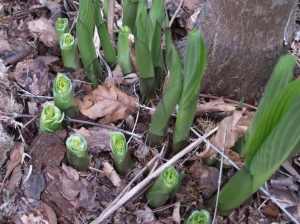
There are several ways to protect your garden, and I must admit that I’ve been too negligent, or lazy, to do much about them in the past. But my wife is getting a bit worked up, so I think that this year I’ll try to summon enough energy to give them a tussle.
Last year, for the first time, I used a preventative spray DEER STOPPER to try to stop the damage. This was successful for a month or more, and then I neglected to do the followup treatment. I was reminded when half of my hostas disappeared overnight. By then the deed was done, so of course it was too late and deer continued to plague the garden. Neglect is a time proven method sure to result in failure.
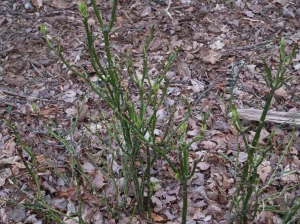
I’ll do it right this year, at least that’s the plan. In addition to spraying or building seven foot tall fences that keep you and the deer out, there are some things that you can do to keep deer damage to your garden to a minimum.
First, use plants that they don’t like, that either taste or smell bad or inflict pain when they try to eat them. In theory, and often in practice, deer will eat just about anything when they’re hungry, particularly in Winter. But there are some plants that have been proven resistant even in the worst situations, though there is no guarantee that plants that are untouched in my garden will work in yours.
I’m not going to attempt a comprehensive list. Even in my garden there are hundreds of plants that deer don’t bother at all, and I’m not going to list them all, but note some highlights to emphasize that there are plenty of plants that will work. You can find lists from groups much more authoritative than me throughout the internet, and most will probably be alright as long as the source is from roughly the same geographic area.
Most of my plants don’t suffer at all, but there are some that would be obvious choices to avoid if you’re not planning preventative measures. As I mentioned before, I used to have a grand collection of Hostas, yellows, blues, variegated leaves, dwarfs and monsters. They’re not gone, but the numbers have diminished as deer have chewed them to ground season after season. Still, some big leafed varieties with corrugatred texture are not eaten at all. Hostas will be my prime target (or rather my wife’s) for preventative spraying this year. If it fails it will be her fault.
 This Winter the Aucubas were chewed to the nub. They have always taken some damage, but far worse this year. There’s not a leaf on them now, but there are plenty of buds and they’ll look good in another month. My large camellias are nearly as bad.
This Winter the Aucubas were chewed to the nub. They have always taken some damage, but far worse this year. There’s not a leaf on them now, but there are plenty of buds and they’ll look good in another month. My large camellias are nearly as bad.
 Azaleas have also taken a beating in my garden. I have deciduous azaleas that are not bothered at all, and Encore azaleas that bloom Spring and Fall. For several years I’ve had very few Spring blooms because the deer chew the top eight or ten inches and most of the leaves off. They rebound nicely by late May and bloom superbly in September and October. Though I have only Encore azaleas, deer cannot tell the difference, an evergreen azalea tastes the same regardless of variety.
Azaleas have also taken a beating in my garden. I have deciduous azaleas that are not bothered at all, and Encore azaleas that bloom Spring and Fall. For several years I’ve had very few Spring blooms because the deer chew the top eight or ten inches and most of the leaves off. They rebound nicely by late May and bloom superbly in September and October. Though I have only Encore azaleas, deer cannot tell the difference, an evergreen azalea tastes the same regardless of variety.
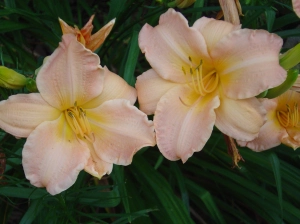 As a joke to friends walking through the garden I’ve often plucked a Daylily flower, taken a bite, rolled it around inside my mouth, and proclaimed with authority, “oh yes, that’s Catherine Woodbury”. I haven’t noticed a taste difference in daylilies (and definitely can’t identify varieties by taste), they all taste like slightly sweet lettuce to me, and I doubt that deer can tell the difference, or even care. But they love those flowers.
As a joke to friends walking through the garden I’ve often plucked a Daylily flower, taken a bite, rolled it around inside my mouth, and proclaimed with authority, “oh yes, that’s Catherine Woodbury”. I haven’t noticed a taste difference in daylilies (and definitely can’t identify varieties by taste), they all taste like slightly sweet lettuce to me, and I doubt that deer can tell the difference, or even care. But they love those flowers.
Deer will also eat the buds and blooms of Roses. The threat of thorns hardly distracts them as they munch on the tender new growth tips and flowers.
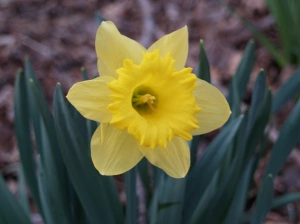 As close to a guarantee as there is in horticulture is that nothing eats Daffodils, not bugs, squirrels, or rabbits, moles, voles, and certainly not deer. And everything eats Tulips. Why? It doesn’t matter, just plant daffodils and not tulips.
As close to a guarantee as there is in horticulture is that nothing eats Daffodils, not bugs, squirrels, or rabbits, moles, voles, and certainly not deer. And everything eats Tulips. Why? It doesn’t matter, just plant daffodils and not tulips. 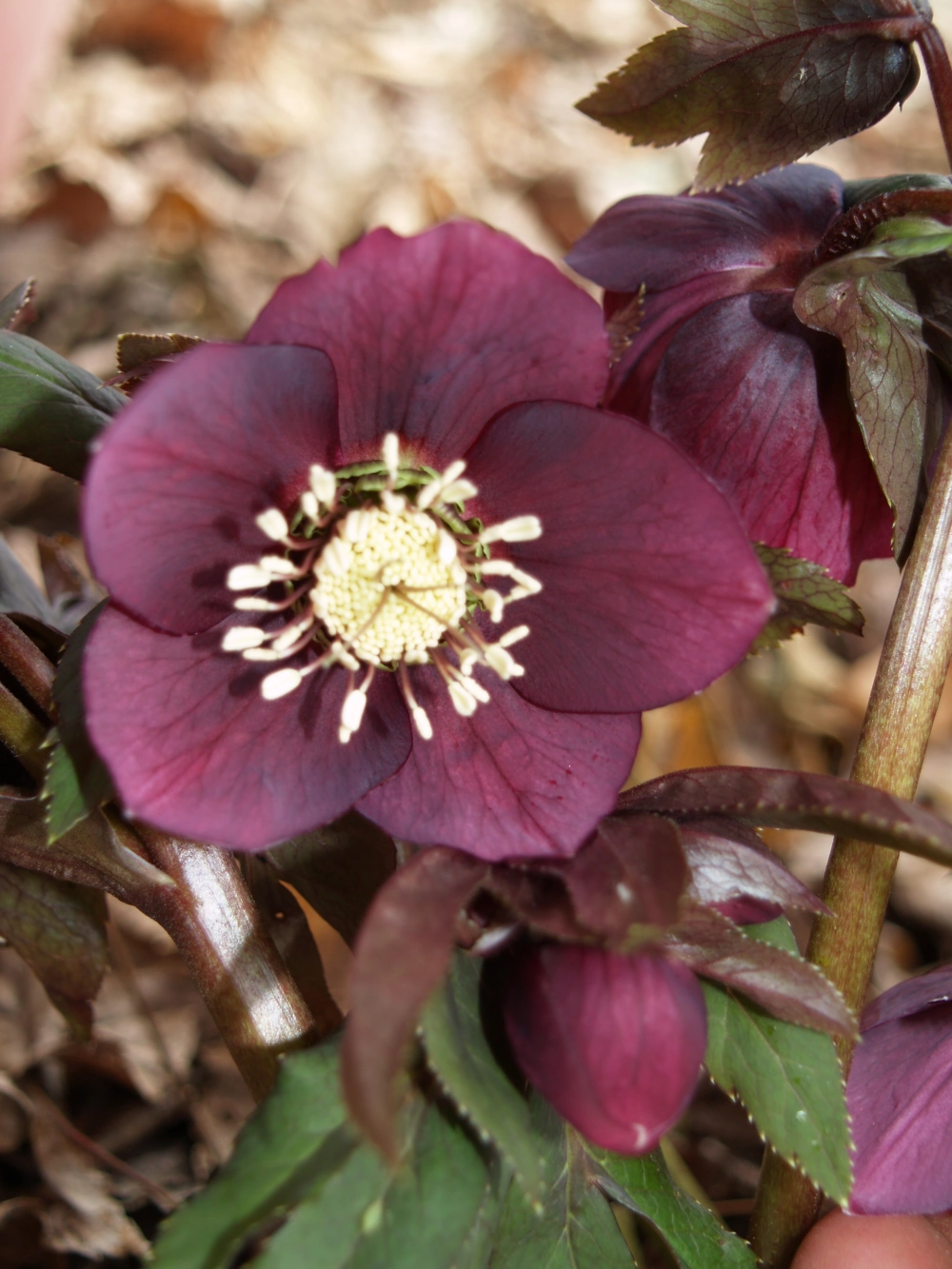
Winter is the time that deer cause the greatest damage to gardens. Though their choice hosta and other perennials are safely dormant, lack of foliage forces them to consume just about anything green. Sprays, fences, and resistant plants often fail to deter ravenous deer, but the delightful February blooming Hellebores are not worthy of even a nibble.
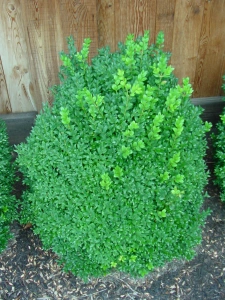 Next to daffodils the safest plants resistant to deer damage are Boxwood and Cephalotaxus. The type boxwood doesn’t seem to matter, none have been bothered by deer in my experience.
Next to daffodils the safest plants resistant to deer damage are Boxwood and Cephalotaxus. The type boxwood doesn’t seem to matter, none have been bothered by deer in my experience.
Cephalotaxus is called plum yew, and its needlelike evergreen foliage is quite similar to the common yew, Taxus, which is a magnet for deer at anytime of the year. The plum yew is slow growing, and is a rare evergreen that grows well in the shade. And deer avoid it completely. I’ve had some damage when deer, or maybe a less nimble critter (me), stepped on and broke branches.
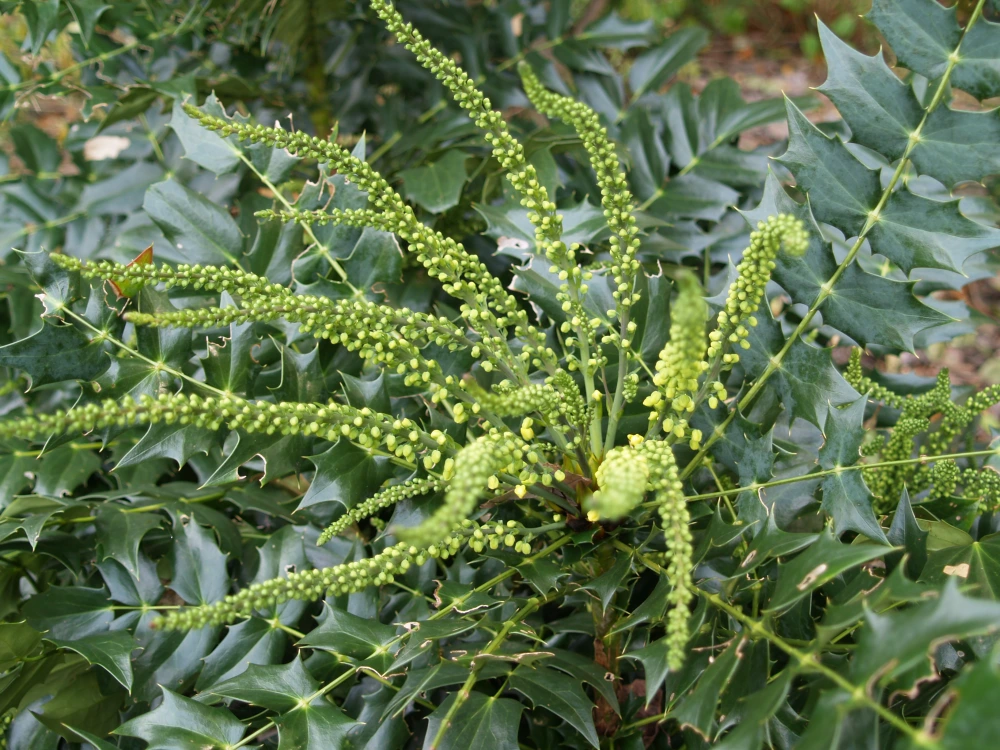 Take a look at the spines at the tips of Mahonia ‘Winter Sun’. They’re even worse than they look. Avoid planting a mahonia where you have to brush it as you walk past. And don’t dare walk around it in bare feet. Someone told me that they had witnessed a mahonia that deer had damaged, but they also reported seeing blood on the leaves. The deer in my neighborhood are much smarter than to try something so foolish.
Take a look at the spines at the tips of Mahonia ‘Winter Sun’. They’re even worse than they look. Avoid planting a mahonia where you have to brush it as you walk past. And don’t dare walk around it in bare feet. Someone told me that they had witnessed a mahonia that deer had damaged, but they also reported seeing blood on the leaves. The deer in my neighborhood are much smarter than to try something so foolish.
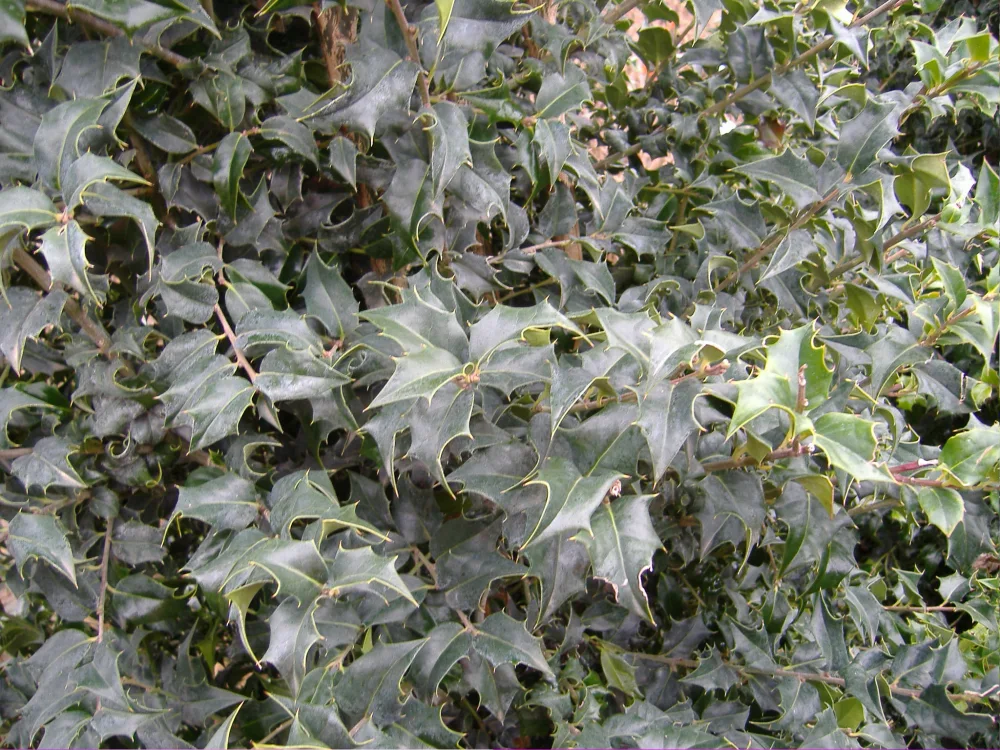 Dragon Lady hollyis almost as spiny as mahonia, is an excellent upright holly that deer will chew on only in extreme circumstances. Excellent hollies such as Nellie Stevens are more likely to be injured.
Dragon Lady hollyis almost as spiny as mahonia, is an excellent upright holly that deer will chew on only in extreme circumstances. Excellent hollies such as Nellie Stevens are more likely to be injured.
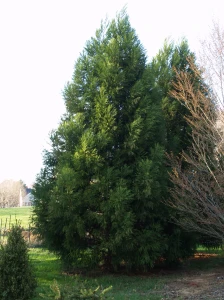 Large evergreens used for screening are also subject to deer damage. The ubiquitous Leyland cypress and Emerald Green arborvitae often fall victim, but the fast growing Green Giant arborvitae is seldom bothered. Cryptomeria, in its range of configurations from low mounds to tall uprights, seems resistant.
Large evergreens used for screening are also subject to deer damage. The ubiquitous Leyland cypress and Emerald Green arborvitae often fall victim, but the fast growing Green Giant arborvitae is seldom bothered. Cryptomeria, in its range of configurations from low mounds to tall uprights, seems resistant.
Pieris , or Andromeda have proven to be resistant. I have a least a handful of varieties from two feet to over six in height, and none have ever been injured.
And briefly, other plants that I have noted in my garden that have resisted deer damage, even when they are right next to plants being eaten.
Deciduous trees – I have never witnessed any damage to any shade or flowering trees in my garden, though I don’t have any apples or pears that are prone to injury. Many are too large, but dogwoods, redbuds, and Japanese maples have branches low enough that deer could reach them.
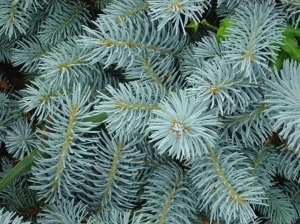 I use small trees and colorful evergreens such as Montgomery spruce as centerpieces in landscape designs, then work smaller plant groupings around them. So, I have less problems creating a workable garden design than others who rely on deer prone perennials, and struggle for ideas in deer infested areas.
I use small trees and colorful evergreens such as Montgomery spruce as centerpieces in landscape designs, then work smaller plant groupings around them. So, I have less problems creating a workable garden design than others who rely on deer prone perennials, and struggle for ideas in deer infested areas.
Spruce, in general, are pretty safe selections, but the needles of Norway spruce can be fairly soft, and there are reports of damage. Colorado spruce needles tend to be stiffer and more resistant.
Viburnums – I have not had any damage, nor heard of it from others.
Perennials – I’ve had no damage to large leaf hostas, hellebores, Japanese iris, stachys, euphorbias, epimediums, baptisia, grasses, and ferns, even when many of these are next to plants that are eaten. Many other perennials haven’t had problems, but they’re in areas that would be difficult for a deer to access, so I don’t have confidence in their resistance.
Though it may seem at times like nothing escapes the ravenous appetite of deer, there are many safe choices that shouldn’t limit the beauty of your garden. If you want to stretch the limits, as I do, then you must explore alternate methods. If I can overcome my innate laziness and keep at a regular preventive spray program I’ll report back on my progress.
Hi Dave,
Great article. You should use DeerPro Winter Animal Repellent to protect woody ornamental shrubs like azaleas, rhododendron and holly from winter deer browsing.
I like the way you describe your post…(almost) deer resistant garden. Your points are right on spot and I enjoyed reading this post.
I don’t know what other wildlife you have, but something is eating my daffodils! I have chewed flowers all over the place.
Could it be Munkjac? (We have lots of them). Someone else suggested squirrels or slugs.
It is unlikely that deer, or their cousins, would eat daffodils. There are scattered reports of rabbits and squirrels munching on daffodils, and also slugs. I’ve not had experience with critters or bugs chewing mine, nor have I witnessed this, so I can only suppose that these reports could have some validity. I did see a photo where spotted piglets were eating daffodils, but I wouldn’t figure that they are roaming gardens.
Have you heard of DeFence? It’s made by Havahart and it’s the most effective repellent I’ve ever tried. Better than liquid fence. And I barely have to apply it. Directions say once every 3 months. Super easy to use.
There are many similar deer repellents, and I am quite confident that any of the products that are based on putrescent egg solids will be comparable in effectiveness. The Havahart website states that its product is effective for up to three months, depending on the number of deer, so I would still feel safer recommending spraying every month or you’re taking your chances. As a side note, I recommend purchasing a concentrate rather than a ready to spray unless your garden is very small. The ready to sprays are used up quickly and are quite a bit more expensive if you plan on spraying regularly. If you don’t plan on spraying regularly I wouldn’t bother spraying at all, since it will be a waste of your time and money.
No idea what kind of viburnum I planted–but they ate it. They haven’t touched my one camellia, though the squirrels must like the buds.
I’m not surprised by anything that deer eat, that’s why I think it’s safer to spray any plants in doubt with a repellent.
I have a Leather leaf viburnum that the deer absolutely destroyed to browse height the last couple of years
In recent years deer have made the lists of resistant plants nearly obsolete. In particular, after this severe and prolonged winter deer have nibbled plants that have never been bothered in prior years. Many evergreens will not be damaged spring through autumn, but only in winter when there is less foliage, so it will be worthwhile to spray evergreens with a repellent in late November for protection.
In winter of 2015 the deer ate my hellebores to the ground. Shoots are coming but are pretty wimpy looking. Deer have also browsed my mature japanese yews as well as younger yews.
Thanks Dave. Deer will eat anything in my six years experience with them. Most of my “rarely damaged” plants have been safe. Another way deer damage trees is the buck rubs the tree trunk with their head and antlers. Three of our eight foot tall Green Giant Arborvitae have long sections of bark scraped off. The bark healed and branches are slowly covering it, but we have now fenced them off until they are wide enough and hope the deer go elsewhere when the trunk is too far inside to reach. My theory for now. The lovely scent of the branches must attract them – it does me!
Hey – I’m in Texas – guy next to me FEEDS THE DEER. So I have heavy deer presence. We put up a fence in the back but anyway they have mostly left the Azealeas alone. Haven’t touched the boxwood at all or the sage and rosemary. Anything smelly (chives, lavender) seems to turn them off. But something ate all my daffodils. :(. And tulips. Any ‘bulb’ plant I’ve tried has been chewed off before they bloom.
Short of a 6 foot fence in front, or cussing out the neighbor, I guess I’m limited to a mostly herb/boxwood garden for a front garden.
I suppose that the only thing worse than the next door neighbor feeding deer is if they don’t get enough to eat at his place.